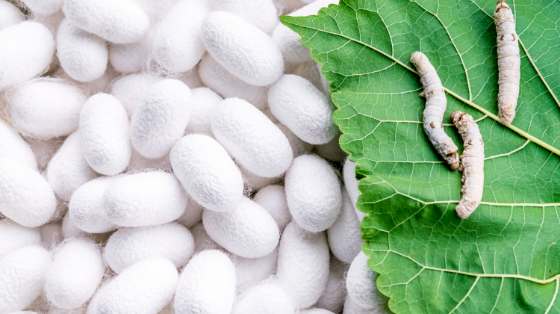
Sericulture is an age old practice of rearing silkworms to make silk by feeding them mulberry leaves and helping them form cocoons. These cocoons are reeled into silk threads which are later used by weavers to make silk garments. This entire process of cultivating mulberry plants and rearing the worms in a rearing house to form cocoons is called 'Sericulture'.
| Estimated Project Costing for Mulberry based Sericulture in 1 acre cultivation with 800DFL | ||
| A | Fixed Capital | (Rs.) |
| 1 | Farm Fencing (Material and Installation Labour Chgs.) | 30,000 |
| 2 | Source of water (Deep Bore Well including Pump set) | 100,000 |
| 3 | Drip Irrigation Cost (Rs 60,000) less 50% subsidy under PMKSY | 30,000 |
| 4 | 12% GST on the total cost of drip irrigation | 7,200 |
| 5 | Construction Cost of Rearing Shed including rack & equipment (1000 sq.ft.) | 350,000 |
| 6 | Cost of Mulberry Sapling pair rowing (material & logistics) (5,000 plants) | 25,000 |
| Total A | 542,200 | |
| B | Project Setup Cost | (Rs.) |
| 1 | Land Preparation Cost | 15,400 |
| 2 | Material Cost | 18,600 |
| Total B | 34,000 | |
| C | Recurring Cost every year | (Rs.) |
| 1 | Cost of cultivation (materials and labour charges) | 24,000 |
| 2 | Cost of DFL @160 DFL / cycle for 5 cycle | 8,000 |
| Total C | 32,000 | |
| TOTAL PROJECT COST | 608,200 |
| Operational Cost - mulberry cultivation per acre | ||
| A | Land Preparation Labour Cost | (Rs.) |
| 1 | Tractor Tilling for land preparation | 4,000 |
| 2 | FYM application | 2,400 |
| 3 | Preparation ridge/furrow/pit making | 6,000 |
| 4 | Planting of Saplings | 3,000 |
| Total Land Preparation Labour Cost | 15,400 | |
| B | Material Cost | (Rs.) |
| 1 | Farmyard manure | 9,600 |
| 2 | Vermicompost/ Bio & Liquid fertilizers | 2,000 |
| 3 | Fertilizers @ 20:20:20 kg NPK/ acre after 2 months of planting ( 200 kg Ammonium sulphate, 125 kg Single Super Phosphate and 35 kg Muriate of Potash and another dose of N@20kg) | 5,000 |
| 4 | Tools / appliances | 1,500 |
| 5 | Fungicide | 500 |
| Total Material Cost | 18,600 | |
| Total Operational Cost | 34,000 | |
| C | Recurring Cost every year | (Rs.) |
| 1 | DFL purchase (160 DFLs X Rs 10 per DFL X 5 Cycles a year) | 8,000 |
| 2 | Materials - FYM + NPK | 8,000 |
| 3 | Labour Service - Rearing | 4,000 |
| 4 | Weeding 4 times a year | 4,800 |
| 5 | Ploughing for intercultural operation (two times/ year) | 1,200 |
| 6 | Irrigation - 40 times a year | 6,000 |
| Annual Recurring Cost | 32,000 |
| Income & Expenditure Statement | (All figures in Rs.) | ||||
| Income | Year 1 | Year 2 | Year 3 | Year 4 | Year 5 |
| Rearing Cycles | 2 | 5 | 5 | 5 | 5 |
| Production of Cocoon in Kg / cycle | 125 | 125 | 125 | 125 | 125 |
| Total Production of Cocoon in Kg | 250 | 625 | 625 | 625 | 625 |
| Average Selling Price / Kg | 500 | 500 | 500 | 500 | 500 |
| Income from sale of Cocoon | 125,000 | 312,500 | 312,500 | 312,500 | 312,500 |
| Total Income | 125,000 | 312,500 | 312,500 | 312,500 | 312,500 |
| Expenditure | |||||
| Recurring cost of Cocoon / year | 10,700 | 32,000 | 32,000 | 32,000 | 32,000 |
| Total Expenditure | 10,700 | 32,000 | 32,000 | 32,000 | 32,000 |
| Net Income | 114,300 | 280,500 | 280,500 | 280,500 | 280,500 |